Abarth 124 Spider 2020 Owner handbook (in English)
Manufacturer: ABARTH, Model Year: 2020, Model line: 124 Spider, Model: Abarth 124 Spider 2020Pages: 224, PDF Size: 3.9 MB
Page 71 of 224

Warning light What it means What to do
KEY INDICATOR LIGHT
Warning light flashing
When the push button start is pressed from
ON to ACC or OFF, the warning light may flash
for approximately 30 seconds indicating that
the remaining battery power of the key is low.Replace with a new battery before the key
becomes unusable.
Blue warning light
Warning light What it means What to do
MAIN BEAM HEADLIGHTS
The warning light switches on when the main
beam headlights are turned on.
LOW ENGINE COOLANT TEMPERATURE
INDICATOR LIGHT
(for versions/markets where provided)
The light illuminates continuously when the
engine coolant temperature is low and turns
off after the engine is warm.
If the low engine coolant temperature indicator
light remains illuminated after the engine has
been sufficiently warmed up, the temperature
sensor could have a malfunction.Contact a Dealership as soon as possible.
69
Page 72 of 224
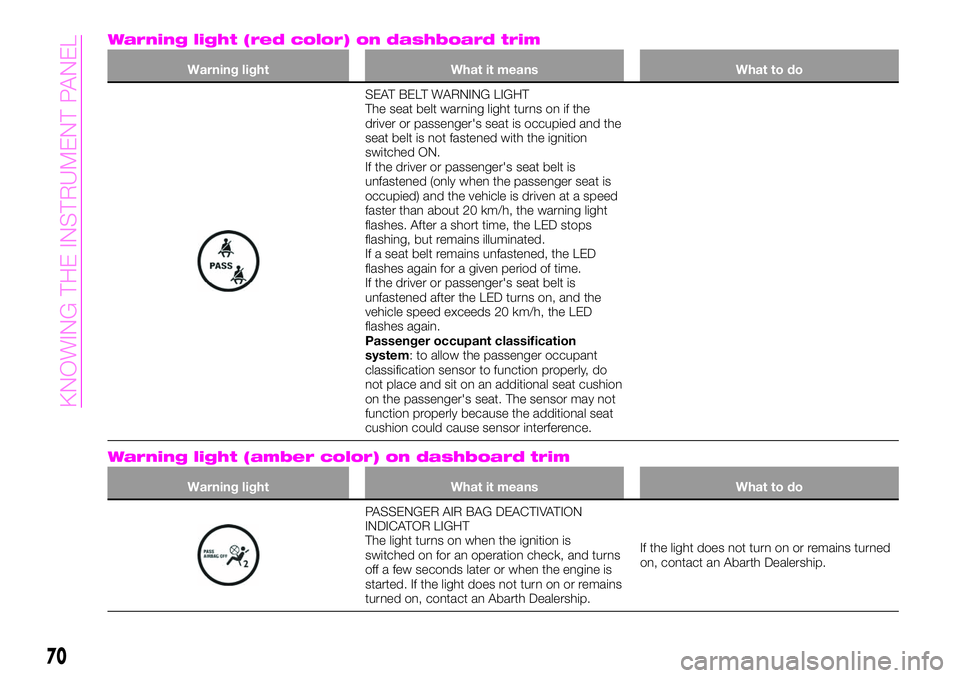
Warning light (red color) on dashboard trim
Warning light What it means What to do
SEAT BELT WARNING LIGHT
The seat belt warning light turns on if the
driver or passenger's seat is occupied and the
seat belt is not fastened with the ignition
switched ON.
If the driver or passenger's seat belt is
unfastened (only when the passenger seat is
occupied) and the vehicle is driven at a speed
faster than about 20 km/h, the warning light
flashes. After a short time, the LED stops
flashing, but remains illuminated.
If a seat belt remains unfastened, the LED
flashes again for a given period of time.
If the driver or passenger's seat belt is
unfastened after the LED turns on, and the
vehicle speed exceeds 20 km/h, the LED
flashes again.
Passenger occupant classification
system: to allow the passenger occupant
classification sensor to function properly, do
not place and sit on an additional seat cushion
on the passenger's seat. The sensor may not
function properly because the additional seat
cushion could cause sensor interference.
Warning light (amber color) on dashboard trim
Warning light What it means What to do
PASSENGER AIR BAG DEACTIVATION
INDICATOR LIGHT
The light turns on when the ignition is
switched on for an operation check, and turns
off a few seconds later or when the engine is
started. If the light does not turn on or remains
turned on, contact an Abarth Dealership.If the light does not turn on or remains turned
on, contact an Abarth Dealership.
70
KNOWING THE INSTRUMENT PANEL
Page 73 of 224
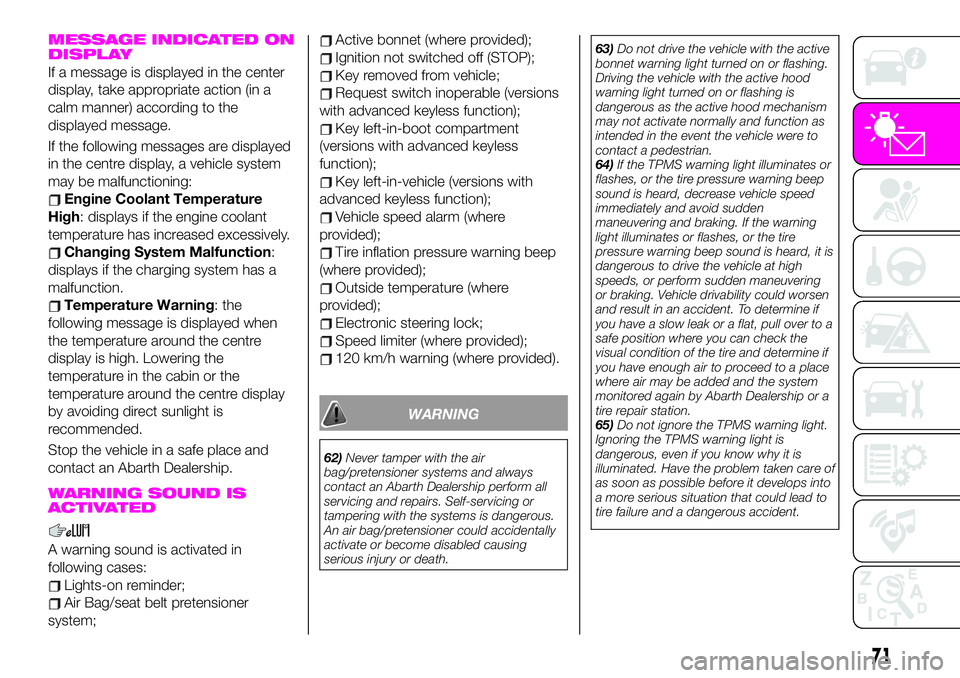
MESSAGE INDICATED ON
DISPLAY
If a message is displayed in the center
display, take appropriate action (in a
calm manner) according to the
displayed message.
If the following messages are displayed
in the centre display, a vehicle system
may be malfunctioning:
Engine Coolant Temperature
High: displays if the engine coolant
temperature has increased excessively.
Changing System Malfunction:
displays if the charging system has a
malfunction.
Temperature Warning: the
following message is displayed when
the temperature around the centre
display is high. Lowering the
temperature in the cabin or the
temperature around the centre display
by avoiding direct sunlight is
recommended.
Stop the vehicle in a safe place and
contact an Abarth Dealership.
WARNING SOUND IS
ACTIVATED
A warning sound is activated in
following cases:
Lights-on reminder;
Air Bag/seat belt pretensioner
system;
Active bonnet (where provided);
Ignition not switched off (STOP);
Key removed from vehicle;
Request switch inoperable (versions
with advanced keyless function);
Key left-in-boot compartment
(versions with advanced keyless
function);
Key left-in-vehicle (versions with
advanced keyless function);
Vehicle speed alarm (where
provided);
Tire inflation pressure warning beep
(where provided);
Outside temperature (where
provided);
Electronic steering lock;
Speed limiter (where provided);
120 km/h warning (where provided).
WARNING
62)Never tamper with the air
bag/pretensioner systems and always
contact an Abarth Dealership perform all
servicing and repairs. Self-servicing or
tampering with the systems is dangerous.
An air bag/pretensioner could accidentally
activate or become disabled causing
serious injury or death.63)Do not drive the vehicle with the active
bonnet warning light turned on or flashing.
Driving the vehicle with the active hood
warning light turned on or flashing is
dangerous as the active hood mechanism
may not activate normally and function as
intended in the event the vehicle were to
contact a pedestrian.
64)If the TPMS warning light illuminates or
flashes, or the tire pressure warning beep
sound is heard, decrease vehicle speed
immediately and avoid sudden
maneuvering and braking. If the warning
light illuminates or flashes, or the tire
pressure warning beep sound is heard, it is
dangerous to drive the vehicle at high
speeds, or perform sudden maneuvering
or braking. Vehicle drivability could worsen
and result in an accident. To determine if
you have a slow leak or a flat, pull over to a
safe position where you can check the
visual condition of the tire and determine if
you have enough air to proceed to a place
where air may be added and the system
monitored again by Abarth Dealership or a
tire repair station.
65)Do not ignore the TPMS warning light.
Ignoring the TPMS warning light is
dangerous, even if you know why it is
illuminated. Have the problem taken care of
as soon as possible before it develops into
a more serious situation that could lead to
tire failure and a dangerous accident.
71
Page 74 of 224
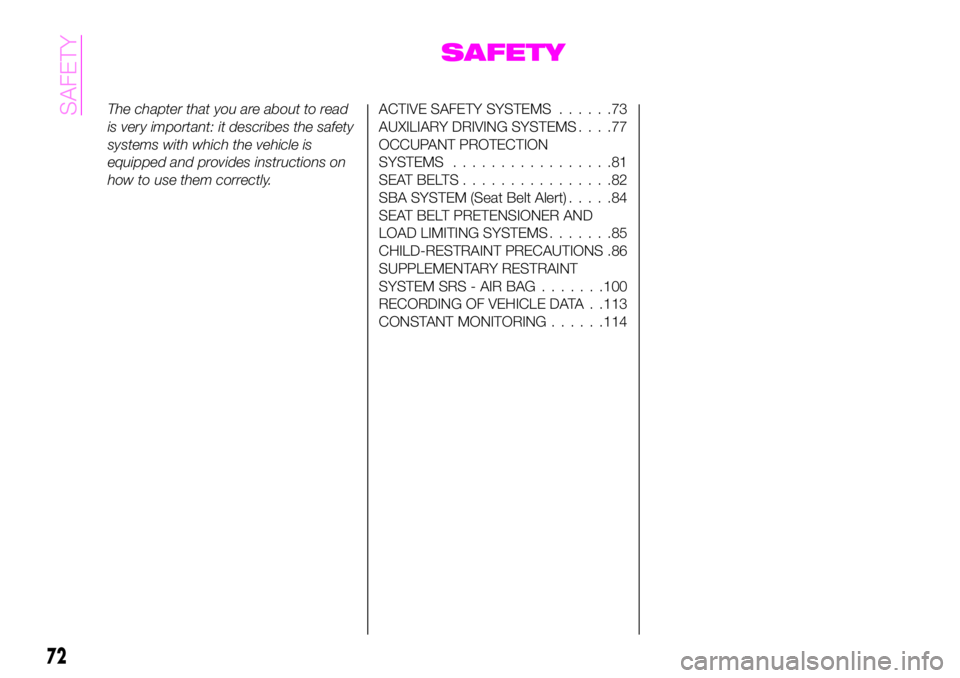
SAFETY
The chapter that you are about to read
is very important: it describes the safety
systems with which the vehicle is
equipped and provides instructions on
how to use them correctly.ACTIVE SAFETY SYSTEMS......73
AUXILIARY DRIVING SYSTEMS....77
OCCUPANT PROTECTION
SYSTEMS.................81
SEATBELTS................82
SBA SYSTEM (Seat Belt Alert).....84
SEAT BELT PRETENSIONER AND
LOAD LIMITING SYSTEMS.......85
CHILD-RESTRAINT PRECAUTIONS .86
SUPPLEMENTARY RESTRAINT
SYSTEM SRS - AIR BAG.......100
RECORDING OF VEHICLE DATA . .113
CONSTANT MONITORING......114
72
SAFETY
Page 75 of 224
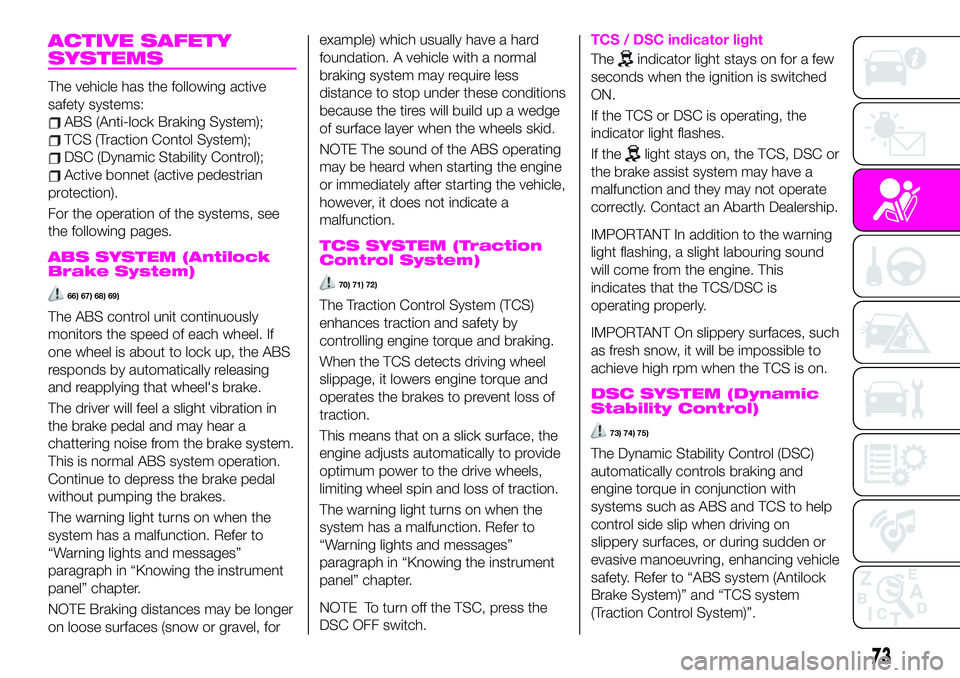
ACTIVE SAFETY
SYSTEMS
The vehicle has the following active
safety systems:
ABS (Anti-lock Braking System);
TCS (Traction Contol System);
DSC (Dynamic Stability Control);
Active bonnet (active pedestrian
protection).
For the operation of the systems, see
the following pages.
ABS SYSTEM (Antilock
Brake System)
66) 67) 68) 69)
The ABS control unit continuously
monitors the speed of each wheel. If
one wheel is about to lock up, the ABS
responds by automatically releasing
and reapplying that wheel's brake.
The driver will feel a slight vibration in
the brake pedal and may hear a
chattering noise from the brake system.
This is normal ABS system operation.
Continue to depress the brake pedal
without pumping the brakes.
The warning light turns on when the
system has a malfunction. Refer to
“Warning lights and messages”
paragraph in “Knowing the instrument
panel” chapter.
NOTE Braking distances may be longer
on loose surfaces (snow or gravel, forexample) which usually have a hard
foundation. A vehicle with a normal
braking system may require less
distance to stop under these conditions
because the tires will build up a wedge
of surface layer when the wheels skid.
NOTE The sound of the ABS operating
may be heard when starting the engine
or immediately after starting the vehicle,
however, it does not indicate a
malfunction.
TCS SYSTEM (Traction
Control System)
70) 71) 72)
The Traction Control System (TCS)
enhances traction and safety by
controlling engine torque and braking.
When the TCS detects driving wheel
slippage, it lowers engine torque and
operates the brakes to prevent loss of
traction.
This means that on a slick surface, the
engine adjusts automatically to provide
optimum power to the drive wheels,
limiting wheel spin and loss of traction.
The warning light turns on when the
system has a malfunction. Refer to
“Warning lights and messages”
paragraph in “Knowing the instrument
panel” chapter.
NOTE To turn off the TSC, press the
DSC OFF switch.
TCS / DSC indicator light
Theindicator light stays on for a few
seconds when the ignition is switched
ON.
If the TCS or DSC is operating, the
indicator light flashes.
If the
light stays on, the TCS, DSC or
the brake assist system may have a
malfunction and they may not operate
correctly. Contact an Abarth Dealership.
IMPORTANT In addition to the warning
light flashing, a slight labouring sound
will come from the engine. This
indicates that the TCS/DSC is
operating properly.
IMPORTANT On slippery surfaces, such
as fresh snow, it will be impossible to
achieve high rpm when the TCS is on.
DSC SYSTEM (Dynamic
Stability Control)
73) 74) 75)
The Dynamic Stability Control (DSC)
automatically controls braking and
engine torque in conjunction with
systems such as ABS and TCS to help
control side slip when driving on
slippery surfaces, or during sudden or
evasive manoeuvring, enhancing vehicle
safety. Refer to “ABS system (Antilock
Brake System)” and “TCS system
(Traction Control System)”.
73
Page 76 of 224
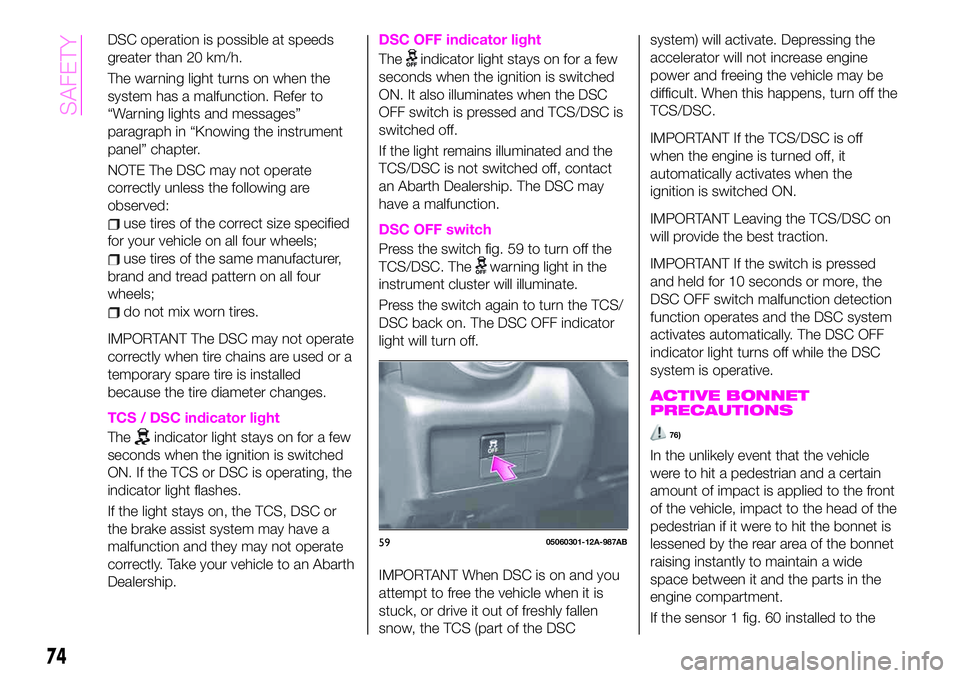
DSC operation is possible at speeds
greater than 20 km/h.
The warning light turns on when the
system has a malfunction. Refer to
“Warning lights and messages”
paragraph in “Knowing the instrument
panel” chapter.
NOTE The DSC may not operate
correctly unless the following are
observed:
use tires of the correct size specified
for your vehicle on all four wheels;
use tires of the same manufacturer,
brand and tread pattern on all four
wheels;
do not mix worn tires.
IMPORTANT The DSC may not operate
correctly when tire chains are used or a
temporary spare tire is installed
because the tire diameter changes.
TCS / DSC indicator light
Theindicator light stays on for a few
seconds when the ignition is switched
ON. If the TCS or DSC is operating, the
indicator light flashes.
If the light stays on, the TCS, DSC or
the brake assist system may have a
malfunction and they may not operate
correctly. Take your vehicle to an Abarth
Dealership.
DSC OFF indicator light
Theindicator light stays on for a few
seconds when the ignition is switched
ON. It also illuminates when the DSC
OFF switch is pressed and TCS/DSC is
switched off.
If the light remains illuminated and the
TCS/DSC is not switched off, contact
an Abarth Dealership. The DSC may
have a malfunction.
DSC OFF switch
Press the switch fig. 59 to turn off the
TCS/DSC. The
warning light in the
instrument cluster will illuminate.
Press the switch again to turn the TCS/
DSC back on. The DSC OFF indicator
light will turn off.
IMPORTANT When DSC is on and you
attempt to free the vehicle when it is
stuck, or drive it out of freshly fallen
snow, the TCS (part of the DSCsystem) will activate. Depressing the
accelerator will not increase engine
power and freeing the vehicle may be
difficult. When this happens, turn off the
TCS/DSC.
IMPORTANT If the TCS/DSC is off
when the engine is turned off, it
automatically activates when the
ignition is switched ON.
IMPORTANT Leaving the TCS/DSC on
will provide the best traction.
IMPORTANT If the switch is pressed
and held for 10 seconds or more, the
DSC OFF switch malfunction detection
function operates and the DSC system
activates automatically. The DSC OFF
indicator light turns off while the DSC
system is operative.
ACTIVE BONNET
PRECAUTIONS
76)
In the unlikely event that the vehicle
were to hit a pedestrian and a certain
amount of impact is applied to the front
of the vehicle, impact to the head of the
pedestrian if it were to hit the bonnet is
lessened by the rear area of the bonnet
raising instantly to maintain a wide
space between it and the parts in the
engine compartment.
If the sensor 1 fig. 60 installed to the
5905060301-12A-987AB
74
SAFETY
Page 77 of 224
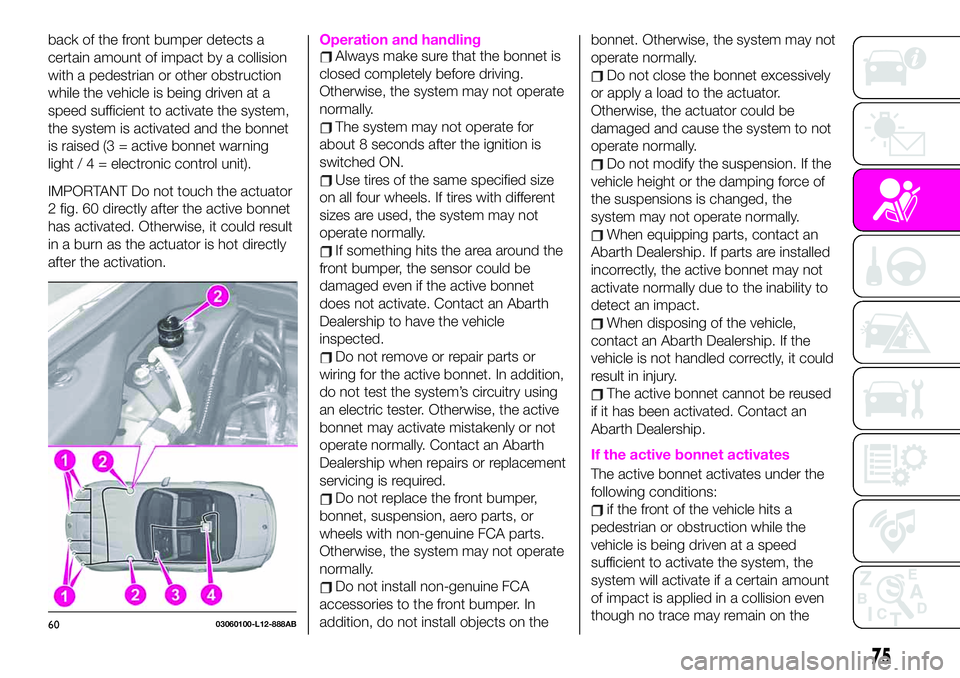
back of the front bumper detects a
certain amount of impact by a collision
with a pedestrian or other obstruction
while the vehicle is being driven at a
speed sufficient to activate the system,
the system is activated and the bonnet
is raised (3 = active bonnet warning
light/4=electronic control unit).
IMPORTANT Do not touch the actuator
2 fig. 60 directly after the active bonnet
has activated. Otherwise, it could result
in a burn as the actuator is hot directly
after the activation.
Operation and handlingAlways make sure that the bonnet is
closed completely before driving.
Otherwise, the system may not operate
normally.
The system may not operate for
about 8 seconds after the ignition is
switched ON.
Use tires of the same specified size
on all four wheels. If tires with different
sizes are used, the system may not
operate normally.
If something hits the area around the
front bumper, the sensor could be
damaged even if the active bonnet
does not activate. Contact an Abarth
Dealership to have the vehicle
inspected.
Do not remove or repair parts or
wiring for the active bonnet. In addition,
do not test the system’s circuitry using
an electric tester. Otherwise, the active
bonnet may activate mistakenly or not
operate normally. Contact an Abarth
Dealership when repairs or replacement
servicing is required.
Do not replace the front bumper,
bonnet, suspension, aero parts, or
wheels with non-genuine FCA parts.
Otherwise, the system may not operate
normally.
Do not install non-genuine FCA
accessories to the front bumper. In
addition, do not install objects on thebonnet. Otherwise, the system may not
operate normally.
Do not close the bonnet excessively
or apply a load to the actuator.
Otherwise, the actuator could be
damaged and cause the system to not
operate normally.
Do not modify the suspension. If the
vehicle height or the damping force of
the suspensions is changed, the
system may not operate normally.
When equipping parts, contact an
Abarth Dealership. If parts are installed
incorrectly, the active bonnet may not
activate normally due to the inability to
detect an impact.
When disposing of the vehicle,
contact an Abarth Dealership. If the
vehicle is not handled correctly, it could
result in injury.
The active bonnet cannot be reused
if it has been activated. Contact an
Abarth Dealership.
If the active bonnet activates
The active bonnet activates under the
following conditions:
if the front of the vehicle hits a
pedestrian or obstruction while the
vehicle is being driven at a speed
sufficient to activate the system, the
system will activate if a certain amount
of impact is applied in a collision even
though no trace may remain on the
6003060100-L12-888AB
75
Page 78 of 224
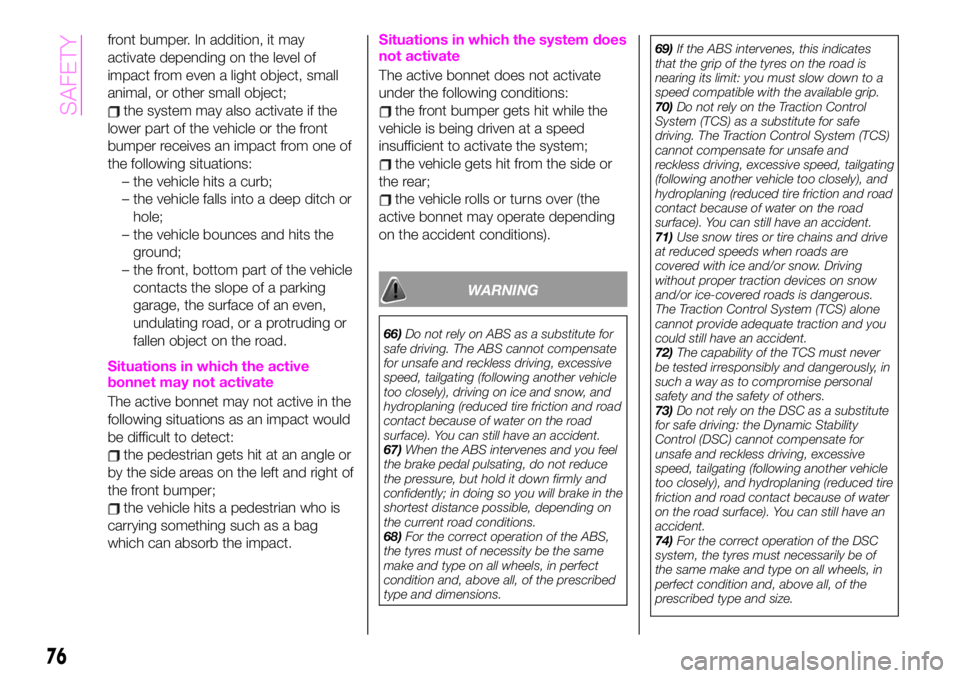
front bumper. In addition, it may
activate depending on the level of
impact from even a light object, small
animal, or other small object;
the system may also activate if the
lower part of the vehicle or the front
bumper receives an impact from one of
the following situations:
– the vehicle hits a curb;
– the vehicle falls into a deep ditch or
hole;
– the vehicle bounces and hits the
ground;
– the front, bottom part of the vehicle
contacts the slope of a parking
garage, the surface of an even,
undulating road, or a protruding or
fallen object on the road.
Situations in which the active
bonnet may not activate
The active bonnet may not active in the
following situations as an impact would
be difficult to detect:
the pedestrian gets hit at an angle or
by the side areas on the left and right of
the front bumper;
the vehicle hits a pedestrian who is
carrying something such as a bag
which can absorb the impact.
Situations in which the system does
not activate
The active bonnet does not activate
under the following conditions:
the front bumper gets hit while the
vehicle is being driven at a speed
insufficient to activate the system;
the vehicle gets hit from the side or
the rear;
the vehicle rolls or turns over (the
active bonnet may operate depending
on the accident conditions).
WARNING
66)Do not rely on ABS as a substitute for
safe driving. The ABS cannot compensate
for unsafe and reckless driving, excessive
speed, tailgating (following another vehicle
too closely), driving on ice and snow, and
hydroplaning (reduced tire friction and road
contact because of water on the road
surface). You can still have an accident.
67)When the ABS intervenes and you feel
the brake pedal pulsating, do not reduce
the pressure, but hold it down firmly and
confidently; in doing so you will brake in the
shortest distance possible, depending on
the current road conditions.
68)For the correct operation of the ABS,
the tyres must of necessity be the same
make and type on all wheels, in perfect
condition and, above all, of the prescribed
type and dimensions.69)If the ABS intervenes, this indicates
that the grip of the tyres on the road is
nearing its limit: you must slow down to a
speed compatible with the available grip.
70)Do not rely on the Traction Control
System (TCS) as a substitute for safe
driving. The Traction Control System (TCS)
cannot compensate for unsafe and
reckless driving, excessive speed, tailgating
(following another vehicle too closely), and
hydroplaning (reduced tire friction and road
contact because of water on the road
surface). You can still have an accident.
71)Use snow tires or tire chains and drive
at reduced speeds when roads are
covered with ice and/or snow. Driving
without proper traction devices on snow
and/or ice-covered roads is dangerous.
The Traction Control System (TCS) alone
cannot provide adequate traction and you
could still have an accident.
72)The capability of the TCS must never
be tested irresponsibly and dangerously, in
such a way as to compromise personal
safety and the safety of others.
73)Do not rely on the DSC as a substitute
for safe driving: the Dynamic Stability
Control (DSC) cannot compensate for
unsafe and reckless driving, excessive
speed, tailgating (following another vehicle
too closely), and hydroplaning (reduced tire
friction and road contact because of water
on the road surface). You can still have an
accident.
74)For the correct operation of the DSC
system, the tyres must necessarily be of
the same make and type on all wheels, in
perfect condition and, above all, of the
prescribed type and size.
76
SAFETY
Page 79 of 224
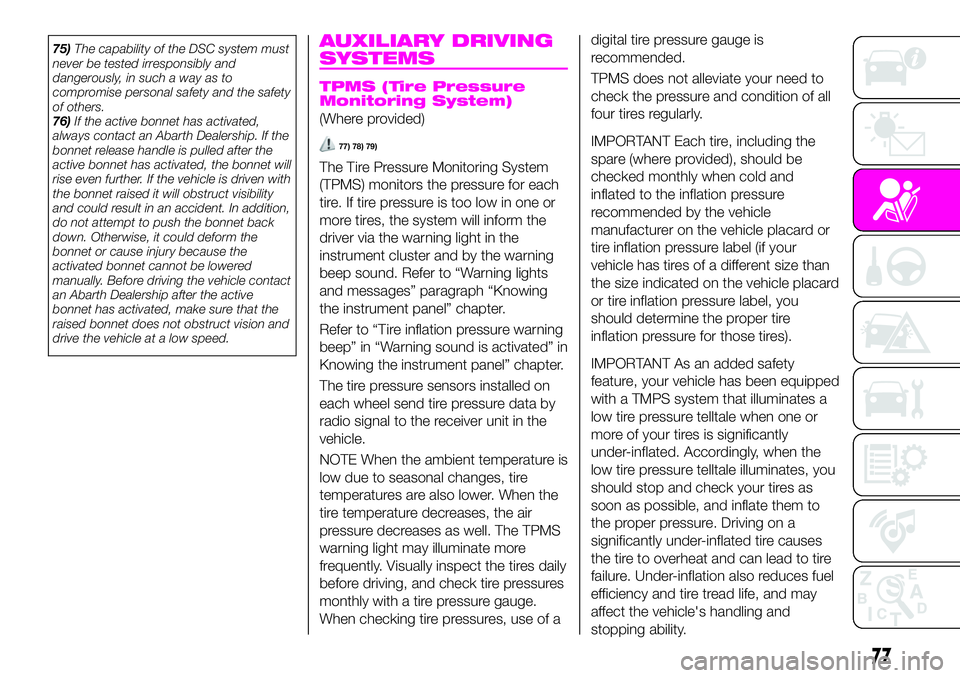
75)The capability of the DSC system must
never be tested irresponsibly and
dangerously, in such a way as to
compromise personal safety and the safety
of others.
76)If the active bonnet has activated,
always contact an Abarth Dealership. If the
bonnet release handle is pulled after the
active bonnet has activated, the bonnet will
rise even further. If the vehicle is driven with
the bonnet raised it will obstruct visibility
and could result in an accident. In addition,
do not attempt to push the bonnet back
down. Otherwise, it could deform the
bonnet or cause injury because the
activated bonnet cannot be lowered
manually. Before driving the vehicle contact
an Abarth Dealership after the active
bonnet has activated, make sure that the
raised bonnet does not obstruct vision and
drive the vehicle at a low speed.AUXILIARY DRIVING
SYSTEMS
TPMS (Tire Pressure
Monitoring System)
(Where provided)
77) 78) 79)
The Tire Pressure Monitoring System
(TPMS) monitors the pressure for each
tire. If tire pressure is too low in one or
more tires, the system will inform the
driver via the warning light in the
instrument cluster and by the warning
beep sound. Refer to “Warning lights
and messages” paragraph “Knowing
the instrument panel” chapter.
Refer to “Tire inflation pressure warning
beep” in “Warning sound is activated” in
Knowing the instrument panel” chapter.
The tire pressure sensors installed on
each wheel send tire pressure data by
radio signal to the receiver unit in the
vehicle.
NOTE When the ambient temperature is
low due to seasonal changes, tire
temperatures are also lower. When the
tire temperature decreases, the air
pressure decreases as well. The TPMS
warning light may illuminate more
frequently. Visually inspect the tires daily
before driving, and check tire pressures
monthly with a tire pressure gauge.
When checking tire pressures, use of adigital tire pressure gauge is
recommended.
TPMS does not alleviate your need to
check the pressure and condition of all
four tires regularly.
IMPORTANT Each tire, including the
spare (where provided), should be
checked monthly when cold and
inflated to the inflation pressure
recommended by the vehicle
manufacturer on the vehicle placard or
tire inflation pressure label (if your
vehicle has tires of a different size than
the size indicated on the vehicle placard
or tire inflation pressure label, you
should determine the proper tire
inflation pressure for those tires).
IMPORTANT As an added safety
feature, your vehicle has been equipped
with a TMPS system that illuminates a
low tire pressure telltale when one or
more of your tires is significantly
under-inflated. Accordingly, when the
low tire pressure telltale illuminates, you
should stop and check your tires as
soon as possible, and inflate them to
the proper pressure. Driving on a
significantly under-inflated tire causes
the tire to overheat and can lead to tire
failure. Under-inflation also reduces fuel
efficiency and tire tread life, and may
affect the vehicle's handling and
stopping ability.
77
Page 80 of 224
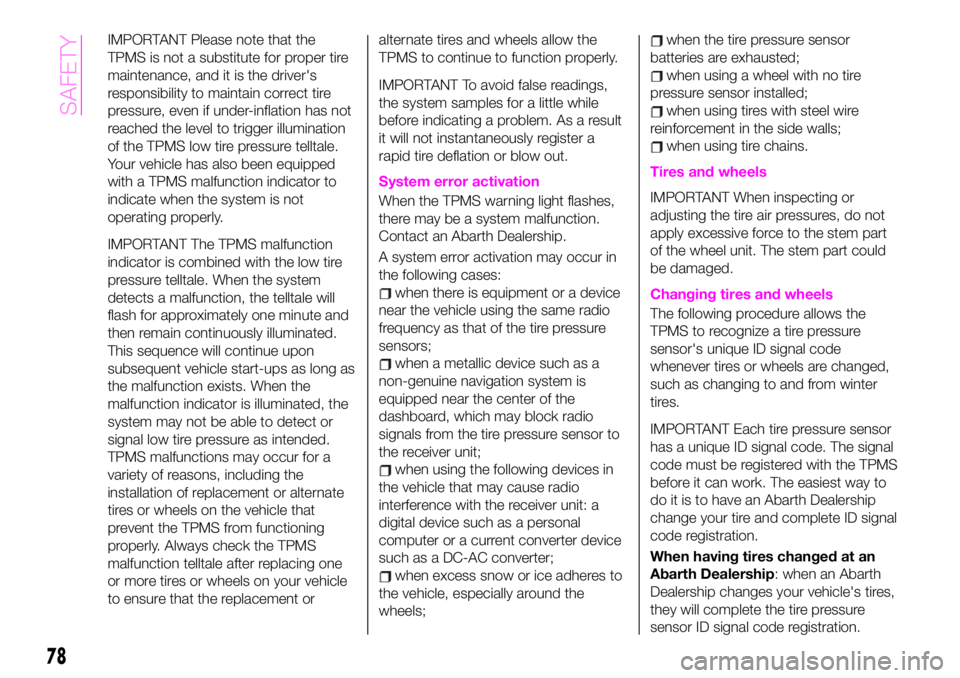
IMPORTANT Please note that the
TPMS is not a substitute for proper tire
maintenance, and it is the driver's
responsibility to maintain correct tire
pressure, even if under-inflation has not
reached the level to trigger illumination
of the TPMS low tire pressure telltale.
Your vehicle has also been equipped
with a TPMS malfunction indicator to
indicate when the system is not
operating properly.
IMPORTANT The TPMS malfunction
indicator is combined with the low tire
pressure telltale. When the system
detects a malfunction, the telltale will
flash for approximately one minute and
then remain continuously illuminated.
This sequence will continue upon
subsequent vehicle start-ups as long as
the malfunction exists. When the
malfunction indicator is illuminated, the
system may not be able to detect or
signal low tire pressure as intended.
TPMS malfunctions may occur for a
variety of reasons, including the
installation of replacement or alternate
tires or wheels on the vehicle that
prevent the TPMS from functioning
properly. Always check the TPMS
malfunction telltale after replacing one
or more tires or wheels on your vehicle
to ensure that the replacement oralternate tires and wheels allow the
TPMS to continue to function properly.
IMPORTANT To avoid false readings,
the system samples for a little while
before indicating a problem. As a result
it will not instantaneously register a
rapid tire deflation or blow out.
System error activation
When the TPMS warning light flashes,
there may be a system malfunction.
Contact an Abarth Dealership.
A system error activation may occur in
the following cases:
when there is equipment or a device
near the vehicle using the same radio
frequency as that of the tire pressure
sensors;
when a metallic device such as a
non-genuine navigation system is
equipped near the center of the
dashboard, which may block radio
signals from the tire pressure sensor to
the receiver unit;
when using the following devices in
the vehicle that may cause radio
interference with the receiver unit: a
digital device such as a personal
computer or a current converter device
such as a DC-AC converter;
when excess snow or ice adheres to
the vehicle, especially around the
wheels;
when the tire pressure sensor
batteries are exhausted;
when using a wheel with no tire
pressure sensor installed;
when using tires with steel wire
reinforcement in the side walls;
when using tire chains.
Tires and wheels
IMPORTANT When inspecting or
adjusting the tire air pressures, do not
apply excessive force to the stem part
of the wheel unit. The stem part could
be damaged.
Changing tires and wheels
The following procedure allows the
TPMS to recognize a tire pressure
sensor's unique ID signal code
whenever tires or wheels are changed,
such as changing to and from winter
tires.
IMPORTANT Each tire pressure sensor
has a unique ID signal code. The signal
code must be registered with the TPMS
before it can work. The easiest way to
do it is to have an Abarth Dealership
change your tire and complete ID signal
code registration.
When having tires changed at an
Abarth Dealership: when an Abarth
Dealership changes your vehicle's tires,
they will complete the tire pressure
sensor ID signal code registration.
78
SAFETY